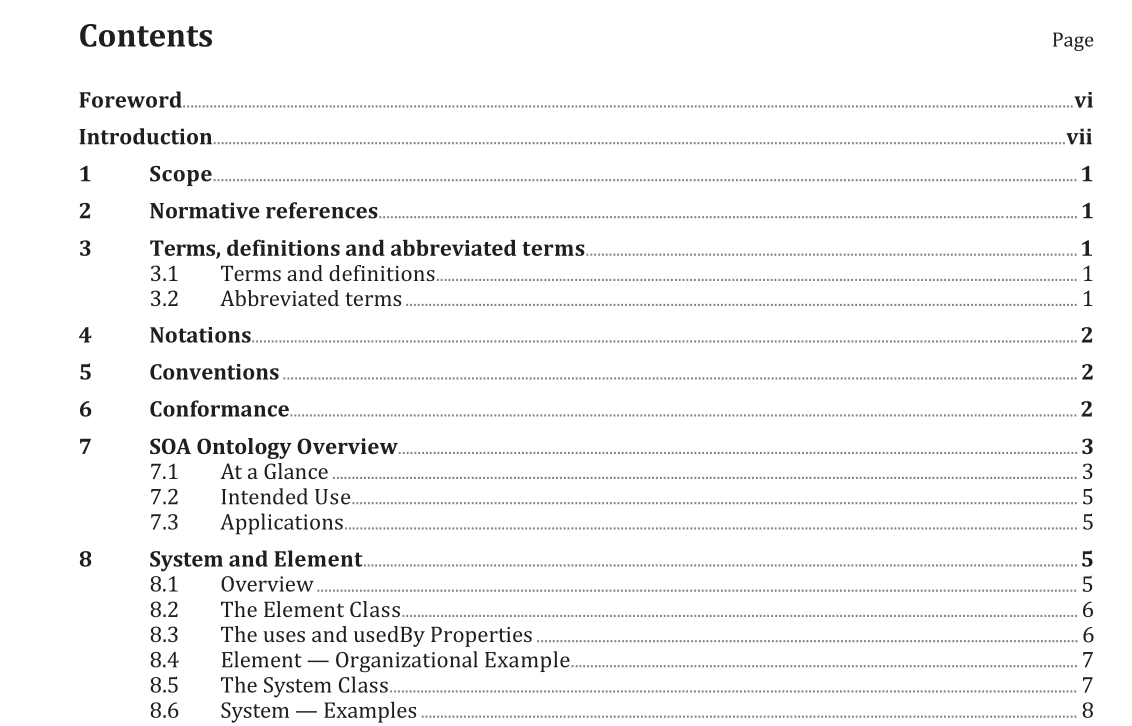BS ISO IEC 18384-3 pdf download.Information technology — Reference Architecture for Service Oriented Architecture (SOA RA)
4 Notations
The ontology is represented in the web ontology language (OWL) defined by the World Wide Web Consortium. OWL has three increasingly expressive sub-languages: OWL-Lite, OWL-DL, and OWL- Full (see Reference [10] for a definition of these three dialects of OWL). This ontology uses OWL-DL, the sub-language that provides the greatest expressiveness possible while retaining computational completeness and decidability. The ontology contains classes and properties corresponding to the concepts of SOA. The formal OWL definitions are supplemented by natural language descriptions of the concepts, with graphic illustrations of the relations between them, and with examples of their use. For purposes of exposition, the ontology also includes UML (see Reference [8]) diagrams that graphically illustrate its classes and properties of the ontology. The natural language and OWL definitions contained in this part of ISO/IEC 18384 constitute the authoritative definition of the ontology; the diagrams are for explanatory purposes only. Some of the natural language terms used to describe the concepts are not formally represented in the ontology; those terms are meant in their natural language sense. The availability of an OWL expression a standard RDF format allows easy loading into tools for architects and developers and allows validation. This part of ISO/IEC 18384 uses examples to illustrate the ontology. One of these, the car-wash example, is used consistently throughout to illustrate the main concepts (see Annex A for the complete example). Other examples are used ad hoc in individual clauses to illustrate particular points.
5 Conventions
Bold font is used for OWL class, property, and instance names where they appear in clause text. Italic strings are used for emphasis and to identify the first instance of a word requiring definition. OWL definitions and syntax are shown in fixed-width font. An unlabeled arrow in the illustrative UML diagrams means subclass. The examples in this part of ISO/IEC 18384 are strictly informative and are for illustrative purposes.
6 Conformance
ISO/IEC 18384 contains three parts which have different conformance requirements: 1. terminology and concepts — conformance only to terms and adherence to the semantics in the definitions; 2. reference architecture for SOA solutions — conformance only to semantics of the metamodel and any Layers, ABBs, or capabilities that are used; 3. SOA Ontology — conformance for OWL or non-OWL applications. Conformance to this part of ISO/IEC 18384 is defined as follows.There are two kinds of applications that may conform to this ontology. One is the OWL-based ontologies (typically extensions of the SOA ontology); the other is a non-OWL application, such as a meta-model or a piece of software (see Clause 2 for the OWL version that is required). A conforming OWL application (derived OWL-based ontology) — shall conform to the OWL standard specified in Clause 2, — shall include the whole of the ontology contained in Annex C, — may add other OWL constructs, including class and property definitions, and — may import other ontologies in addition to the SOA ontology. This part of ISO/IEC 18384 does not use any OWL 2 (see Reference [15]) constructs; however, conforming applications may choose to use OWL or OWL 2. A conforming non-OWL application — shall include a defined and consistent transformation (at least semantic mapping) to a non-trivial subset of the ontology contained in Annex C, — may add other constructs, including class and property definitions, and — may import and/or use other ontologies in addition to the SOA ontology.
7 SOA Ontology Overview
7.1 At a Glance A graphically compressed visualization of the entire ontology is shown in Figure 1. The concepts illustrated in Figure 1 are described in the body. This part of ISO/IEC 18384 starts by explaining the most basic foundational concept of elements and systems followed by explaining the elements of SOA human actor and task and then service concepts and descriptions and contracts for services and building on that to explain compositions of services. Finally, this part of ISO/IEC 18384 wraps up with Policies and Events which are relevant to all of the elements of SOA.
BS ISO IEC 18384-3 pdf download
